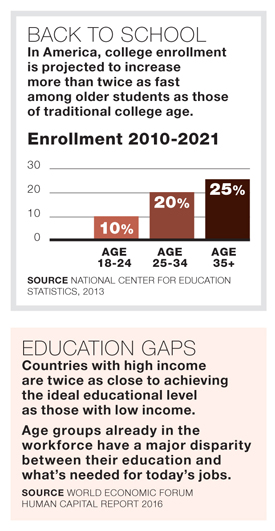The Future of Learning | Designing the Future
Self-directed, connected, and “interest-powered”—and disrupted as never before
SOCIAL STUDIES“We have to focus on a deeper understanding of the relational nature of learning” says Brigid Barron, associate professor at the school of education at California’s Stanford University. A faculty colead of the Learning in Informal and Formal Environments (LIFE) center, Barron and her colleagues explore the importance of social learning environments through the National Science Foundation–funded project.
 Educators, including librarians, have a large role to play in supporting a new paradigm of youth learning. Adults who move beyond simple explanation into “brokering, consulting, and collaboration” and “socialize positive attitudes toward innovation” are more able to “position young people in authentic roles as contributors,” Barron tells LJ.
Educators, including librarians, have a large role to play in supporting a new paradigm of youth learning. Adults who move beyond simple explanation into “brokering, consulting, and collaboration” and “socialize positive attitudes toward innovation” are more able to “position young people in authentic roles as contributors,” Barron tells LJ.
Social learning also supports the development of identity. “Learning environments can be designed to help foster a sense of connection,” explains Barron. “When learners begin to develop their own projects, set their own goals, find resources that support expertise development, build relationships…and be recognized by others for their expertise, we can be confident that their learning is becoming more committed.”
Says Barron, “Libraries and librarians have unique roles to play in the broader educational ecosystem.” Ideally this would result in “the design of hybrid forms of curriculum-based learning” that “serve to build cultural learning pathways.”
The LIFE center is also investigating how to create “equitable access to learning opportunities for parents with younger children, in particular how families use media in their learning practices.” Barron notes that “we need to understand more about how adults in community spaces and in homes can position learners in ways that help connect them to additional opportunities to learn and develop practice-linked identities.”
Barron mentions that “it is likely that new forms of professional development will be needed” to support innovative learning models for youth. As for further research, Barron hopes it will move away from focusing on individuals to group dynamics.—April Witteveen
 Creative Schools: The Grassroots Revolution That’s Transforming Education by Ken Robinson (Viking, 2015) Lesson Plan: An Agenda for Change in American Higher Education by William G. Bowen & Michael S. McPherson(Princeton Univ., Mar. 2016) A School of Our Own: The Story of the First Student-Run High School and a New Vision for American Education by Samuel Levin & Susan Engel (New Pr., Sept. 2016)
Creative Schools: The Grassroots Revolution That’s Transforming Education by Ken Robinson (Viking, 2015) Lesson Plan: An Agenda for Change in American Higher Education by William G. Bowen & Michael S. McPherson(Princeton Univ., Mar. 2016) A School of Our Own: The Story of the First Student-Run High School and a New Vision for American Education by Samuel Levin & Susan Engel (New Pr., Sept. 2016) Connecting the Dots
To fulfill the need for new forms of professional development, one source to consider is Mega Subramaniam, associate professor and associate director, Information Policy and Access Center (iPAC), University of Maryland, and the ConnectedLib project. Under the leadership of lead principal investigator Katie Davis, the goal of ConnectedLib is to create a tool kit that will offer professional support and best practices for librarians who will then “incorporate digital media into their work with youth to promote connections across learning contexts,” according to the project’s website. It builds on the connected learning (CL) model developed by researcher Mizuko (Mimi) Ito and her team: learning should be interest-powered, peer-supported, and academically oriented.
 In the first of three grant-funded years, Subramaniam surveyed librarians about their knowledge of CL practice and how they are implementing CL. While data analysis is still in the preliminary phase, the ConnectedLib team has begun to notice broad themes. “Many libraries are doing [CL] activities but don’t realize it,” says Subramaniam. While library programming for youth regularly connects with interest-powered and peer-supported learning, they don’t often hit the mark for being academically focused. “They need support to be more intentional,” remarks Subramaniam.
In the first of three grant-funded years, Subramaniam surveyed librarians about their knowledge of CL practice and how they are implementing CL. While data analysis is still in the preliminary phase, the ConnectedLib team has begun to notice broad themes. “Many libraries are doing [CL] activities but don’t realize it,” says Subramaniam. While library programming for youth regularly connects with interest-powered and peer-supported learning, they don’t often hit the mark for being academically focused. “They need support to be more intentional,” remarks Subramaniam.
Stay tuned to the ConnectedLib website as the research team begins to publish complete findings in the upcoming months.—AW
RELATED
ALREADY A SUBSCRIBER? LOG IN
We are currently offering this content for free. Sign up now to activate your personal profile, where you can save articles for future viewing










Add Comment :-
Comment Policy:
Comment should not be empty !!!